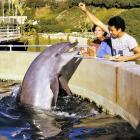The capture and captive life of animals on display has resulted in political and ethical debates, none more so than that of large marine mammals held captive throughout the world. While historians and sociologists of science have written on the development and practice of captivity practices at zoos, few scholars have looked at the development of these methods in aquariums.
Between 1908 and 1928, the New York Aquarium (NYA) developed methods for capturing and maintaining dolphins, resulting not only in knowledge about captivity requirements but also in mass deaths and suffering. The NYA’s early attempts at maintaining dolphins for display show how popular these animals were and how far the NYA would go in trying to provide this spectacle for their visitors.
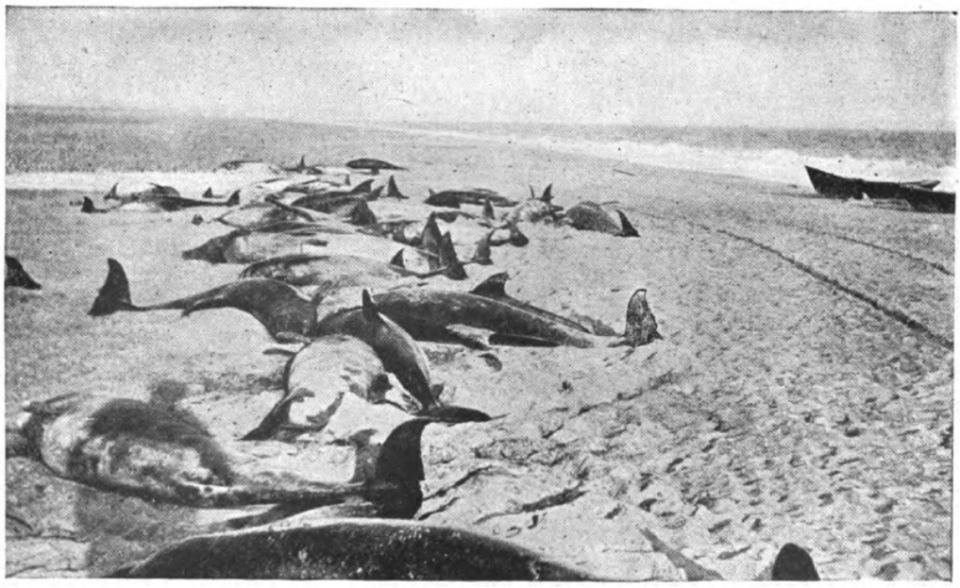
Fig. 1. Photograph of the dolphin fishery at Cape Hatteras, North Carolina, at the turn of the twentieth century.
Fig. 1. Photograph of the dolphin fishery at Cape Hatteras, North Carolina, at the turn of the twentieth century.
Photograph by Jos. K. Nye, n.d.
Originally published in Haskins, Guide to the New York Aquarium (New York: New York zoological society, 1925): 125.
 This work is licensed under a Creative Commons Public Domain Mark 1.0 License.
This work is licensed under a Creative Commons Public Domain Mark 1.0 License.
Charles Haskin Townsend, the director of the aquarium, purchased live dolphins from the only commercial dolphin fishery operating in the United States. The William T. Nye Watch and Clock Oil company operated a commercial whaling operation out of New Bedford, Massachusetts, and a dolphin fishery in Cape Hatteras, North Carolina. Their fishery was for food and oil, but Townsend worked with them to ship live dolphins from Cape Hatteras to New York every summer (figure 1). Beginning in 1908, the NYA purchased between two and five dolphins a year.
The difficulty in keeping captive dolphins began with collection and shipping. Dolphins require moist conditions but cannot be shipped in tanks because of the injuries sustained against the sides. In 1914, Charles Breder Jr., the head aquarist at the NYA, designed a specialized shipping container and sent the plans to Cape Hatteras. The box was meant to be a carriable scaffold into which a piece of canvas was suspended so that the dolphin was never laid flat during transport. Water could be introduced to the dolphin from above and the sides of the container. This device increased the number of dolphins that arrived at the NYA alive and without serious injury (figure 2).
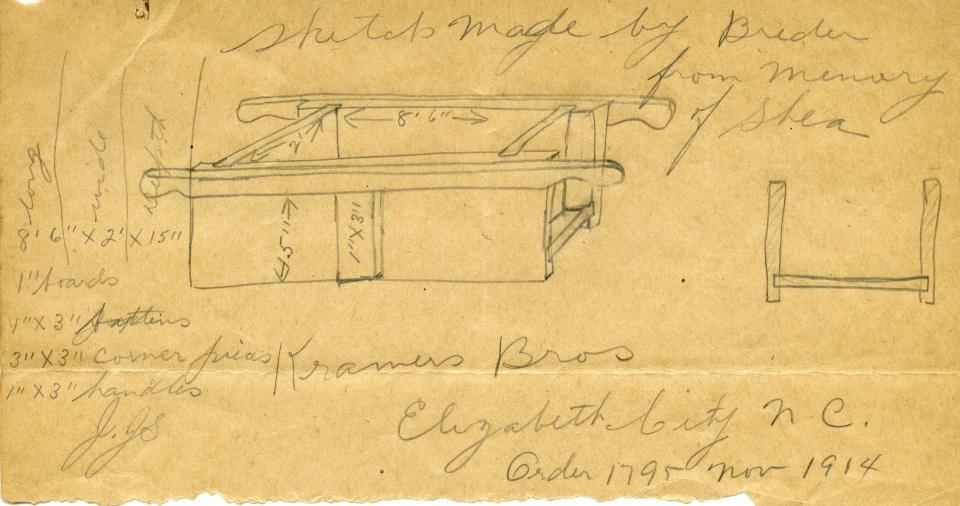
Figure 2. Charles Breder Jr., the head aquarist at the NYA, made this sketch of a dolphin box to send to the dolphin fishery in 1914.
Figure 2. Charles Breder Jr., the head aquarist at the NYA, made this sketch of a dolphin box to send to the dolphin fishery in 1914.
© Wildlife Conservation Society. Reproduced by permission of the WCS Archives.
Papers of Charles Haskins Townsend, folder “animal trade, porpoises ‘1914–1916, 1926–1928,’” Wildlife Conservation Society Archives, Bronx, New York.
The copyright holder reserves, or holds for their own use, all the rights provided by copyright law, such as distribution, performance, and creation of derivative works.
But even if the dolphins arrived at the NYA in good health, tank environments needed to be tailored to their needs. The most basic problem of maintaining aquatic animals in captivity is calibrating water chemistry. In 1908, Townsend wrote that the NYA had finally switched their marine exhibits to pure seawater instead of brackish water from the New York Harbor. However, the switch was too late to save two porpoises that lived less than four weeks upon their arrival. He stated that the “troublesome and expensive losses due to bad water” had largely been eliminated after the switch; the seals and sea lions were in the new water and thriving.
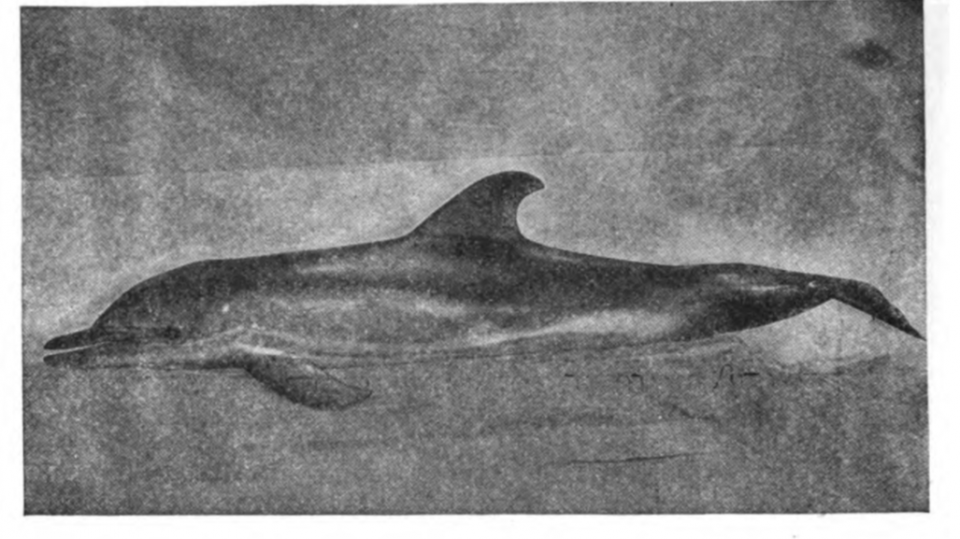
Figure 3. This photograph shows a dolphin at the NYA around 1918. Townsend writes in his book Guide to the New York Aquarium (1919) that they usually have bottlenose dolphins but have also displayed dusky dolphins, common dolphins, and white whales (beluga). I have not found any information about these other species in the NYA archives or published materials.
Figure 3. This photograph shows a dolphin at the NYA around 1918. Townsend writes in his book Guide to the New York Aquarium (1919) that they usually have bottlenose dolphins but have also displayed dusky dolphins, common dolphins, and white whales (beluga). I have not found any information about these other species in the NYA archives or published materials.
Unknown photographer, c. 1918.
Source: Townsend, Charles Haskins. Guide to the New York Aquarium. New York: New York Zoological Society, 1925.
 This work is licensed under a Creative Commons Public Domain Mark 1.0 License.
This work is licensed under a Creative Commons Public Domain Mark 1.0 License.
After the work with transportation and water chemistry, Townsend announced to the administrators of the Aquarium that he had succeeded in starting a “school” of healthy dolphins. It is unclear what his definition of success was, but it was certainly short lived; by the next year, the dolphins purchased for that season began dying rapidly. On May 2, 1915, Townsend sketched a small dolphin figure in the margins of his daily accounts next to a short note: “From Cape Hatteras 4 porpoises (Tursiops truncatus) one came in dead.” On May 5, he noted another death, and on January 4, the final porpoise from this group died. In his book Guide to the New York Aquarium (1919), he states that the longest a dolphin had survived at the NYA was almost two years.1
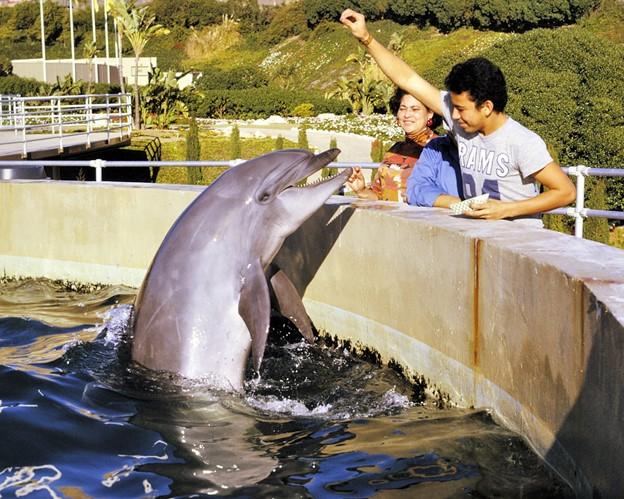
Dolphin performing at Marineland of the Pacific, 1973.
Dolphin performing at Marineland of the Pacific, 1973.
Photograph by edk7, 1973.
Accessed on 25 January 2022. Click here to view source.
 This work is licensed under a Creative Commons Attribution-ShareAlike 2.0 Generic License.
This work is licensed under a Creative Commons Attribution-ShareAlike 2.0 Generic License.
Despite ailing dolphins and continuous deaths, the seasonal display was popular with aquarium visitors. In an article, Townsend stated that “no more popular exhibition of marine life has ever been made at the Aquarium,” and although he mentioned that the dolphins were “expensive boarders,” eating over 90 pounds of fish a day, public interest was high enough that the NYA purchased at least five dolphins a year, even when the average life span was only a few months. Townsend mainly includes images of dolphins in the wild in his article, but there is one photograph of a captive dolphin included (figure 3). The photograph is blurry but shows a dolphin swimming in a shallow pool of water, an indication that the NYA had not worked out the space requirements of this marine mammal, which certainly led to the persistent mortalities.
Charles Townsend responded to crowd enjoyment by continuing to struggle to develop methods for dolphin captivity. However, by 1926, the fishery at Cape Hatteras found it difficult to provide dolphins to the NYA. There appear to have been two problems: The first is that it seems as if dolphins were becoming difficult to obtain in the Cape Hatteras area due to overharvesting. The second is that the small number of dolphins available were not available during warmer shipping times. These difficulties, combined with a change in leadership at the Aquarium, spelled the end of dolphin exhibits. It wasn’t until Marineland in Florida (1938) and Sea World (1959) began to successfully display dolphins for extended periods that dolphin performances became popular (figure 4).
1 Townsend uses the term porpoise here but also uses the scientific name for the Atlantic bottlenose dolphin. He was writing about dolphins.
How to cite
Muka, Samantha. “Early Struggles to Maintain Captive Dolphins at the New York Public Aquarium.” Environment & Society Portal, Arcadia (Spring 2022), no. 6. Rachel Carson Center for Environment and Society. doi:10.5282/rcc/9381.
ISSN 2199-3408
Environment & Society Portal, Arcadia
 This work is licensed under a Creative Commons Attribution 4.0 International License.
This work is licensed under a Creative Commons Attribution 4.0 International License.
2022 Samantha Muka
This refers only to the text and does not include any image rights.
Please click on the images to view their individual rights status.
- Bender, Daniel E. The Animal Game: Searching for Wildness at the American Zoo. Cambridge, MA: Harvard University Press, 2017.
- Braverman, Irus. Zooland: The Institution of Captivity. Stanford, CA: Stanford University Press, 2012.
- Colby, Jason Michael. Orca: How We Came to Know and Love the Ocean's Greatest Predator. Oxford: Oxford University Press, 2018.
- Muka, Samantha, and Chris Zarpentine. “Cetacean conservation and the ethics of captivity.” Biological Conservation 262 (2021): 109303. doi:10.1016/j.biocon.2021.109303.
- Nyhart, Lynn K. Modern Nature: The Rise of the Biological Perspective in Germany. Chicago: University of Chicago Press, 2009.



